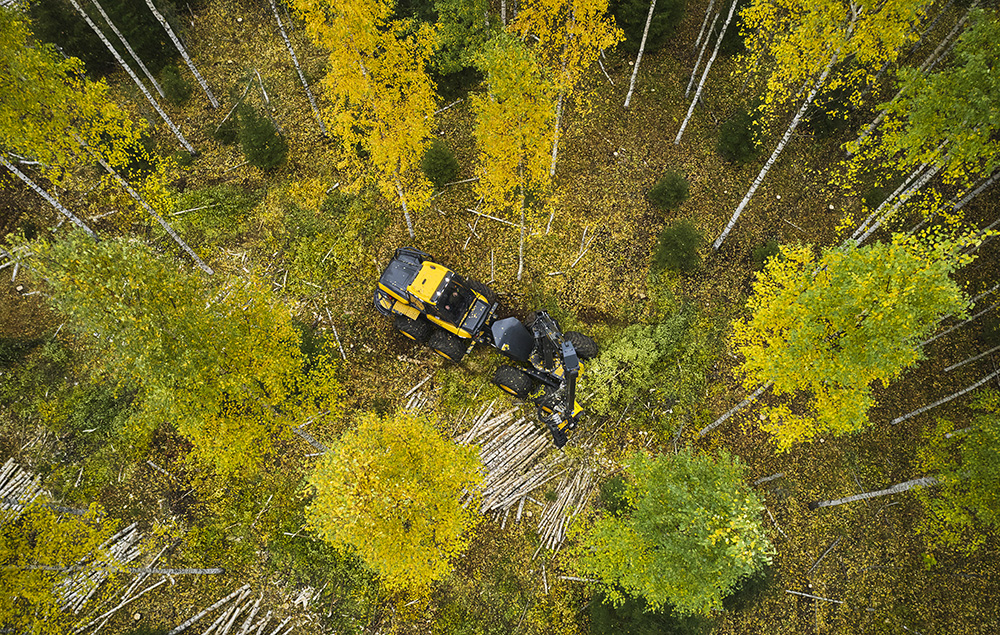Products and services as part of sustainable forestry
- Innovating sustainable solutions that respect the environment
- Promoting environmentally friendly CTL harvesting
- Extending the life cycles of PONSSE forest machines through environmentally positive aftersales services
We are committed to developing sustainable and innovative harvesting solutions. According to our stakeholders’ expectations, environmental aspects have become significant guiding factors in R&D. The sustainability of our customers’ operations is also affected by our investments in minimising fuel consumption, fuel, and tree and soil damage, as well as in the continuous development of our maintenance service processes.
Lifecycle emissions
We have identified the environmental impact generated during the lifecycle of Ponsse’s products and services using LCAs in accordance with the ISO 14040 standard. During the assessments, we have investigated the environmental impact arising from the manufacturing and transport of machines, their use in different conditions, and machine maintenance. The majority of lifecycle emissions contributing to global warming, roughly 95%, comes from the consumption of fuel in machines and the production of fuel. The highest transport emissions are associated with machine deliveries from the Vieremä factory to customers and the transport of machines between stands.
R&D continuously focuses on reducing the consumption of fuel. Fuel efficiency, meaning the consumption of fuel relative to the volume of wood harvested, is a key cost factor in harvesting, which is why our development work is guided by both financial and environmental factors. Our R&D enables PONSSE forest machines to be com - patible with renewable fuels and biodegradable hydraulic oils.
Machine maintenance
During maintenance, the most significant environmental factors are the oils, tyres and spare parts used in machines. Ponsse’s authorised maintenance service network takes care of the appropriate handling of waste. The focus in our maintenance services is on preventive maintenance to avoid any unexpected breakage and carry out maintenance safely for the environment and mechanics. Regular machine maintenance and inspection included in
maintenance agreements ensure that machines operate optimally and as planned without any breakage.
This also eliminates any unnecessary consumption of material and extends the machine lifecycle. In 2023, the coverage of maintenance agreements was 47% (2022: 37) in our new machine sales.

PONSSE forest machines are based on cut-to-length (CTL) harvesting. Machines have been developed to utilise the highly valuable wood raw material and cause the least damage to the soil. Nordic expertise and methods related to the sustainable use of forests offer a solution to minimise global forest loss, while renewable wood is required as a raw material to replace plastic and concrete.
Regeneration methods and obligations in commercial forests, harvesting technologies and forest management methods play an important role when forest resources are required for carbon sequestration and as raw materials, not forgetting biodiversity in forests.
The advanced computing capacity of CTL forest machines allows the best possible value to be extracted from forests. This means more than financial gain. By optimising the yield and processing value of the raw material, the maximum amount of sawn timber with a long-term carbon sequestration capacity can be produced.
Supports all harvesting methods
CTL machines support all harvesting methods from first thinning to continuous cover forestry and regeneration felling. For all harvesting methods, we make sure that the forest can regenerate quickly and reliably – as only the healthy growth of the next tree generation enables the continuation of the forest cycle and the regeneration of the raw material. To enable different harvesting methods, our machines must be balanced and strong, allowing for the long crane reach required at thinning sites.
The aim of CTL harvesting is to minimise machine trails. Eight-wheeled PONSSE forest machines have a balanced weight distribution, and correctly selected tracks can have a significant impact on machine trails. Forwarders have the greatest impact on trails because they drive over the same path multiple times. CTL harvesters typically leave branches and crowns on the trail to protect the soil from forwarders. Large load spaces also mitigate machine trails because capacious machines need to make fewer runs.
